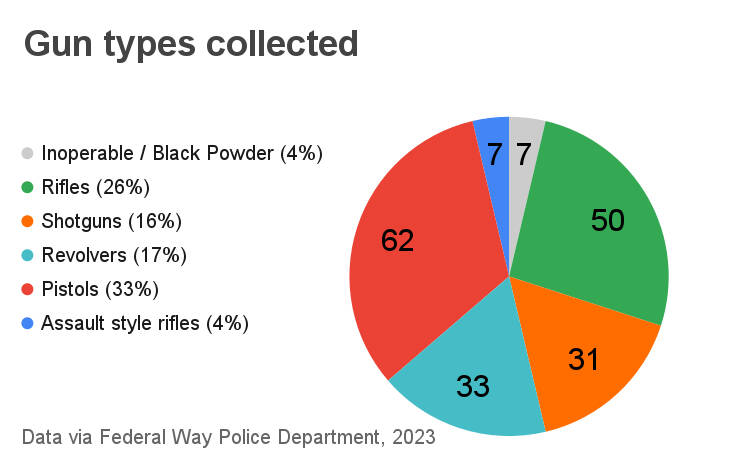Federal Way Police collected nearly 200 firearms at the city’s gun buyback program Saturday, from 3D printed guns to revolvers and antique sporting shotguns and rifles.
A total of $25,000 in gift cards were handed out to participants on Feb. 4, funded through the police department’s budget in the general fund, Mayor Jim Ferrell said.
Several people chose to turn in firearms without receiving compensation, Federal Way Police spokesperson Kurt Schwan said, and others chose to leave after they stopped handing out the gift cards. The voluntary event was advertised for residents in and around Federal Way, but open to anyone with a firearm they wanted to turn in.
Each of the functional guns collected will undergo a ballistics test. Most of the guns will be melted down, Schwan said, but some may be retained for training purposes or donated to the Washington State Patrol crime laboratory to assist their research in ballistics testing. The entire process will take several months, he said.
The goal of gun buybacks is to reduce the number of guns that are in the hands of people who don’t want or shouldn’t have them.
As an example, guns can be voluntarily surrendered from households where they otherwise may be misused in suicide attempts or domestic violence situations, or accessed by children, according to FWPD. Reducing unwanted guns also lowers the risk of a law-abiding person’s gun being stolen and used in the commission of a crime, the department said.
Schwan said the most common reason participants cited for attending the vent was to safely dispose of a weapon they inherited from a loved one who had passed away.
The department also collected ammunition, reloading materials parts and other accessories in an amount “far too vast to count or estimate,” Schwan said.
Research on gun buybacks
The core goal of gun buybacks is to reduce gun violence. A 2022 review of research into buy-backs by Harvard University’s Journalist’s Resource program found mixed results in their success, suggesting that more research is needed.
That body of research hasn’t found much evidence that the programs, on their own, directly reduce gun violence. But they may serve educational value, modestly reduce the risk of gun suicides and be helpful if used as part of a broader effort to reduce gun violence, according to researchers.
About two-thirds of gun deaths are suicides, according to the Centers for Disease Control and Prevention.
A 2021 study in the Annals of Surgery of 19 buyback programs found that while “more rigorous data and evaluation” is needed, “evidence suggests that there may be a small, improved impact in suicide prevention in older, white males, but no effect on interpersonal gun violence or homicides.”
But a 2021 paper published by the National Bureau of Economic Research analyzed 335 gun buyback events and found they had “done little to reduce gun crime or firearm-related violence,” including suicides. It also raised concern that buybacks may temporarily embolden some criminals in the short term.
Buyback programs run into problems, according to that paper, when the prices offered are too low, when the participants come from low crime risk populations, or when the guns returned are older and less functional than the average firearms.
By those metrics, Federal Way’s program did several things supported by the research: The buyback collected a significant total of 190 guns, and it offered higher compensation for those more likely to be used in killings.
Most homicides are committed with handguns, according to the U.S. Department of Justice, and one-third of those collected at the Federal Way event alone were pistols.
Participants at the Federal Way buyback were limited to 10 firearms per vehicle and received compensation based on the gun turned in: $25 for antique or inoperable weapons and some accessories; $50 for modern muzzle-loading firearms; $100 for rifles, shotguns and revolvers; $200 for pistols and full-automatic converted handguns and $300 for AR-15s, AK-47s and rifle or carbine machine guns. (With only a few exceptions, machine guns are generally not legal to own in Washington State.)
While buybacks won’t solve gun violence, this one was a way for the city to secure guns and get them out of houses where they’re no longer wanted or safe, Mayor Ferrell said.
“Is that the silver bullet, so to speak? Probably not,” Ferrell said. “But every bit helps … and it also raises awareness about gun (safety).”
Gun safety
All firearm owners can and should take common-sense steps to ensure their firearms are never used in a tragedy, including:
• Take firearm safety and handling courses.
• Keep guns secured, unloaded and totally out of the reach of children, and ensure discipline around gun handling for household members.
• Give guns away temporarily to a law enforcement agency, or otherwise get them out of the house, if the owner or someone else in the house is in crisis and might be a risk to themselves or others.
• Always treat a firearm as if it’s loaded, keep your finger off the trigger until you decided to fire it, and never point a gun at anything you are not willing to shoot.
Talk to us
Please share your story tips by emailing editor@kentreporter.com.
To share your opinion for publication, submit a letter through our website https://www.kentreporter.com/submit-letter/. Include your name, address and daytime phone number. (We’ll only publish your name and hometown.) Please keep letters to 300 words or less.

